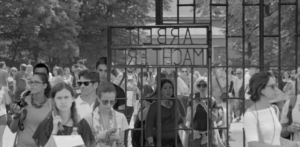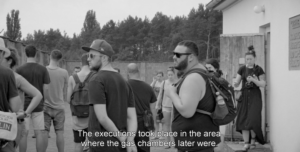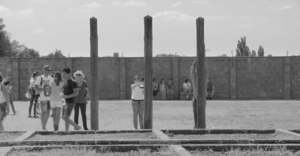
Siegfried Kracauer, a film theorist and philosopher of history, believed that the medium of early cinema was such that made it possible for film not only to record, but also to redeem reality. Sergei Loznitsa’s 2016 film Austerlitz uses black and white images, an unmovable camera, very long shots, no special camera angles, no spectacular montage: an hour and a half long reportage taking the viewer on an excursion around a memorial. Loznitsa’s camera does not hide and does not have to hide, a professional film maker being just one among hundreds and hundreds in the crowd of tourists taking picture opportunities. Loznitsa’s cinema – an apparatus filming other apparatuses — is the one that apparently “…shares […] its affinity for the visible world around us.” (Kracauer, 1960, p. ix)
The “world around us” in this case is a monument of the Holocaust, a former Nazi concentration and extermination camp, later a Soviet POW camp, until 1992 a national memorial in the GDR, and since 1993 the Sachsenhausen Memorial and Museum. The history of the multiple uses and reuses of this complex, the redefinition of its memory, the re-developing of its territories, and the reconstruction of its facilities are presented on the memorial’s website.1 As a result, there is hardly anything authentic left there. The reality of Sachsenhausen today, like any other memorial, is that of an installation, an experience park.
In the eyes of the viewer of Loznitsa’s film, Sachsenhausen is entirely limited to the spectacle of its perception (by the tourists) and mediation (by the guides and the design of the facilities): the stories told, the expressions on the faces of the listeners, their body language, and the gazes contemplating something that for me remains invisible. Film redeems what it records: the reality of our present day appropriation of the history of the Holocaust. Ironically, the tragic past returns in the hysteria and sensationalism of concentration camp tourism. Loznitsa does not judge, but records those half-naked bodies making selfies in front of the gate with its emblematic, carefully preserved Arbeit macht frei decoration. Cinema, Kracauer tells us, represents “life at its most ephemeral.” (Ibid.) In Loznitsa’s movie, an utterly vulnerable and ridiculously vain life tries to immortalize itself by posing in front of a camera at a site that once was instrumental in life’s total destruction.
Not the Holocaust, but the visit to the site of the Holocaust itself becomes an object of commemoration: memorializing memorialization, a double displacement of the event. In Loznitsa’s film, nature itself seems to be commenting on the tourists’ progress through Sachsenhausen’s parade of attractions: the gate, the barrack, the Appellplatz, the gallows, the gas chambers, the crematorium, back to the gate, and out into freedom. The birds twitter, the wind whistles, the leaves whisper, the gravel crackles under footsteps, the old doors creak, the guides tell their tales (which the subtitles sometimes translate and sometimes do not), the cell phones ring, and there is someone praying. In Russian, “to film” or “to photograph” (snimat’) is related to sniatie (Eng. “sublation”), the Aufhebung of Hegelian dialectics, meaning “lifting up” at the same time as “cancelling”, “suspending”, and “abolishing”. A similar principle organizes the narrative in W. G. Sebald’s Austerlitz, the novel which the title of the film refers to. Sebald narrates his story through the narrative of an anonymous storyteller inside the novel, who in turn quotes Austerlitz’s (the main character) own narrative which, in turn, includes quotes from still other persons: “… it was certainly Evan, said Austerlitz, who once told me that…”

Mediation and mediatedness is the main theme, via a whole complex apparatus including the European politics of history and collective memory, institutional policies, intellectual, academic, and cultural capital, the income made by the numerous agencies organizing masses of schoolchildren, activists, and those travelling for pleasure. They stream inside the former inferno through the carefully preserved gate, and represent the cruelest, most pitiless parody of those other marches of seventy years earlier, through that very (or very similar) gate, an entrance for hundreds of thousands and an exit for just a few. The present parodies the past: a parodic return of history, tragedy repeating itself as farce. Loznitsa presents us with a cinematic world after tragedy –and without tragedy. Cinema is the opposite of tragedy, an all embracing parody that essentially is “…an open-ended, limitless world which bears little resemblance to the finite and ordered cosmos set by tragedy” (ibid., p. x). The memorial is a parodic repetition of “the finite and ordered cosmos” of an extermination camp.
W. G. Sebald’s Austerlitz exerted a strong influence on the film, especially since one of its central episodes concerns the visit to Theresienstadt, a former concentration camp turned memorial. There is also a movie inside the novel, and the experience of a profound and irreversible transformation in a moment of serendipity, when Austerlitz perceives the living presence of dead people in the remainders of a Nazi propaganda film. The movie gives him a momentary realization comparable to what happened to Prince Andrei on the battlefield, prostrate and dying under the gaze of his former idol, the victorious Napoleon. The sky over Austerlitz: the revelation of the ultimate, the great instance of man’s total defeat, a face-to-face with the “after” of history, an eye-to-eye with the Last Things.
He had forgotten that his name was Austerlitz and nothing was disturbing him in his deep oblivion except for a strange ability to see ghosts among the living: “the dead […] who knew they had been cheated of what was due to them and tried to return to life […] Sometimes, it was as if I were in a dream and trying to perceive reality; then again I felt as if an invisible twin brother were walking beside me, the reverse of a shadow…” (Sebald, p. 54) The film from Theresienstadt instantaneously connects him with his real self, and his present with his forgotten childhood, an explosion of remembrance that would drive him further and further on ever after, on an endless journey in search of his parents’ fate.
Sebald’s Austerlitz becomes Kracauer’s Ahasuerus: wandering through a universal history, in eternity, seeking to solve the mystery of his name and his defeat, a personal heaven over the field of a lost battle. This is how Kracauer describes Ahasuerus: “I imagine him to be many faces, each reflecting one of the periods which he traversed and all of them combining into ever new patterns, as he restlessly, and vainly, tries on his wanderingsto reconstruct out of the times that shaped him the one time he is doomed to incarnate.” (Kracauer, 1969, p. 157) The multiple faces in Loznitsa’s film are the face(s) of Ahasuerus, the face(s) of Austerlitz. While on their excursion in Sachsenhausen, the tourists also seem to be followed by the gazes of the dead, “a higher form of stereometry”, in which “…we who are still alive are unreal in the eyes of the dead, that only occasionally, in certain lights and atmospheric conditions, do we appear in their field of vision.” (Sebald, p. 185)
“We do not understand the laws governing the return of the past”, Sebald says Austerlitz says, because our historical doctrine tells us that we are the subjects of history and historical consciousness. In actual reality, it is the gaze of the dead directed at us that gives us a name and a history. True, it is only “occasionally” – by pure contingency – that we find ourselves at the crucial moment of the opening of the skies over Austerlitz, when the past returns to us to lead us out of the maze of historical facts into the realm of the Last Things beyond tragedy, where physical realities can be redeemed by simply recording their ephemeral existence (which, as we remember, is what cinema does). The dead return because “they have been cheated of something”. The memorial serves as a movie theater for the dead to watch the living, to record their living existence, and to redeem their existence for history and memory.
At the end of the film, we see the tourists (who appear relieved rather than enriched) leaving the territory of the memorial. After the passage through Sachsenhausen’s artificial environments, the parody of the not-quite-really-direct imprisonment gives way to the genuine and unbounded enjoyment of emancipation. Eventually, Austerlitz the Ahasuerus would also be released from the bondage of his heritage: when he has achieved the vision of the totality of the past, after having gone through the experiences of particular fragmented histories, at the end of Times, at the moment of his disintegration.

1 http://www.stiftung-bg.de/gums/en/accessed May 7th, 2017.
Bibliographie
Kracauer, Siegfried, 1960, Theory of film: the redemption of physical reality, Oxford U.P., New York.
Kracauer, Siegfried, 1969, History: the last things before the last, New York.
Sebald, W. G., 2001, Austerlitz, transl. by Antonia Bell, Random House, New York.
Publié dans Mémoires en jeu, n°4, septembre 2017, p. 9-11
